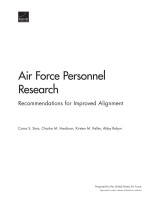| 来源类型 | Research Reports
|
| 规范类型 | 报告
|
| 来源ID | RR-814-AF
|
| Air Force Personnel Research: Recommendations for Improved Alignment |
| Carra S. Sims; Chaitra M. Hardison; Kirsten M. Keller; Abby Robyn
|
| 发表日期 | 2014
|
| 出版年 | 2014
|
| 页码 | 98
|
| 语种 | 英语
|
| 结论 |
The 1991 Disestablishment of the Air Force Human Resources Laboratory Has Left a Void in Air Force Personnel Research and Development- Historically, the Air Force Human Resources Laboratory (AFHRL) was tasked with responsibility for personnel research and development. With AFHRL and its heirs gone, no organization has had that same level of responsibility for research and the broad, strategic research and development focus for many years. Although some research and the collection of a variety of personnel data have continued, there is no single resource for consumers of personnel research.
- Air Force personnel research efforts are currently decentralized, with several different organizations involved in collecting personnel-related data and conducting personnel-related research.
- Although many of the key elements of a smoothly working personnel research system exist in the Air Force or can be brought to bear with help from outside contractors, the system is not optimal. Specifically, this report identifies some critical issues that inhibit the quality and efficiency of personnel research efforts, including narrow organizational missions, inconsistent data-collection coordination and data sharing, a lack of internal personnel research expertise, limited resources, reliance on contractors, and potential duplication of effort.
|
| 摘要 |
- An organizational structure is needed that has clear oversight responsibility over all the personnel research efforts ongoing in the Air Force.
- This structure must have sufficient authority to coordinate the disparate elements of the Air Force's existing personnel research system.
- This organizational element must include institutional knowledge to help determine true gaps in knowledge and the collection of the most-ideal data to fill these gaps.
- Quality control would ensure that ongoing and one-off research efforts meet minimum standards for quality and utility.
- Additional personnel research expertise, and resources would enable the Air Force to optimize its personnel system and operate as efficiently as possible without overburdening existing or new organizational structures.
- Data should be shared more efficiently without upsetting other vital priorities and missions.
- Increased visibility of the structure to the wider Air Force would enable it to serve as a clearinghouse.
- The authors recommend inclusion of a strategic research and development component.
- The oversight structure could be leanly composed of a few key personnel. This course maximizes speed and economics over quality.
- The various personnel research organizations could be reorganized under a single oversight organization. This course of action maximizes quality and would likely not be either economical or fast.
- A hybrid approach could also make sense: a new directorate with a division focused on job analysis-type data collection and a second directorate incorporating the other, more-disparate elements of personnel research activities. This course does not explicitly optimize or sacrifice cost, speed, or quality.
|
| 主题 | Military Personnel
; United States Air Force
; Workforce Management
|
| URL | https://www.rand.org/pubs/research_reports/RR814.html
|
| 来源智库 | RAND Corporation (United States)
|
| 资源类型 | 智库出版物
|
| 条目标识符 | http://119.78.100.153/handle/2XGU8XDN/107857
|
推荐引用方式
GB/T 7714 |
Carra S. Sims,Chaitra M. Hardison,Kirsten M. Keller,et al. Air Force Personnel Research: Recommendations for Improved Alignment. 2014.
|
|
文件名:
|
x1509992748474.jpg
|
|
格式:
|
JPEG
|

|
文件名:
|
RAND_RR814.pdf
|
|
格式:
|
Adobe PDF
|
除非特别说明,本系统中所有内容都受版权保护,并保留所有权利。